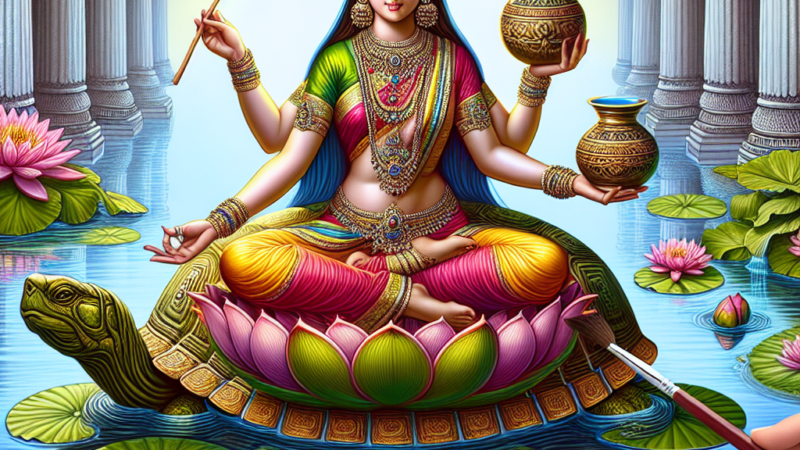Yaksha: The Nature Spirits and Guardians of Wealth
Introduction

Yaksha, in Hindu mythology, are nature spirits and guardians of wealth. These supernatural beings are often depicted as benevolent caretakers of the natural world, as well as protectors of hidden treasures. Yakshas hold a significant place in Hinduism, embodying the dual aspects of nature’s bounty and its hidden dangers. They are revered for their role in maintaining the balance of nature and are often invoked in rituals and ceremonies related to prosperity and protection.
The importance of Yakshas in Hinduism is multifaceted. They are considered to be the custodians of the earth’s riches, including minerals, gems, and other natural resources. Additionally, they are seen as protectors of forests, mountains, and other natural habitats. Their role as guardians of wealth makes them integral to various religious practices and beliefs surrounding prosperity and abundance.
Etymology and Meaning
Origin of the Name Yaksha
The term “Yaksha” is derived from the Sanskrit root “yakṣ,” which means “to worship” or “to sacrifice.” This etymology reflects their ancient association with rituals and offerings. The word “Yaksha” appears in various ancient texts, including the Vedas, Puranas, and epics like the Mahabharata and Ramayana.
Variations of the Name Across Different Texts or Regions
Yakshas are known by different names and variations across various regions and texts. In some South Indian traditions, they are referred to as “Yakshis” when depicting female spirits. In Buddhist texts, they are known as “Yakkhas,” and in Jainism, they are called “Yakshas” or “Yakshinis” for female counterparts.
Symbolic Meaning of the Name
The name Yaksha symbolizes their dual nature as both benevolent and malevolent beings. They are seen as protectors of wealth and nature, but they can also be fierce guardians who punish those who disrespect the natural world. This duality is a recurring theme in Hindu mythology, where deities often embody both creative and destructive forces.
Mythological Origins and Stories
Major Myths and Stories Associated with Yaksha
One of the most famous stories involving a Yaksha is found in the Mahabharata. In the “Yaksha Prashna” episode, Yudhishthira, the eldest of the Pandavas, encounters a Yaksha who poses a series of philosophical questions. Yudhishthira’s wisdom and humility in answering these questions earn him the Yaksha’s favor, leading to the revival of his brothers who had been rendered unconscious.
Yaksha’s Role in Major Hindu Epics
In the Ramayana, Yakshas are mentioned as inhabitants of the mythical city of Lanka, ruled by the demon king Ravana. They are depicted as powerful beings who serve Ravana but also possess their own distinct identities and roles within the epic’s narrative.
Other Significant Tales or Folklore Involving Yaksha
In various regional folklore, Yakshas are often depicted as guardians of specific natural sites, such as forests, rivers, and mountains. They are believed to protect these areas from human exploitation and are often invoked in local rituals to ensure the fertility of the land and the well-being of the community.
Iconography and Symbols
Description of How Yaksha is Depicted in Art, Statues, and Temples
Yakshas are typically depicted as robust, dwarf-like figures with a friendly demeanor. They are often shown holding a pot of treasure or a cornucopia, symbolizing their role as guardians of wealth. In some depictions, they are shown with fierce expressions, emphasizing their protective nature.
Common Symbols Associated with Yaksha
Common symbols associated with Yakshas include the pot of treasure, the cornucopia, and various natural elements like trees and mountains. These symbols highlight their connection to nature and their role as custodians of the earth’s riches.
Meaning and Significance of These Symbols
The pot of treasure symbolizes abundance and prosperity, while the cornucopia represents the bounty of nature. Trees and mountains emphasize their role as protectors of natural habitats. These symbols collectively underscore the Yakshas’ dual role as guardians of both wealth and the natural world.
Worship and Rituals
Festivals Dedicated to Yaksha
While there are no major festivals exclusively dedicated to Yakshas, they are often invoked during rituals related to wealth and prosperity. For example, during Diwali, the festival of lights, offerings are made to various deities, including Yakshas, to ensure prosperity and abundance in the coming year.
Common Rituals and Practices for Worshipping Yaksha
Common rituals for worshipping Yakshas include offering fruits, flowers, and incense at sacred groves or natural sites believed to be inhabited by these spirits. In some regions, small shrines dedicated to Yakshas can be found near forests or rivers, where locals offer prayers and perform rituals to seek their blessings.
Sacred Texts or Mantras Associated with Yaksha
While there are no specific sacred texts dedicated solely to Yakshas, they are mentioned in various Hindu scriptures, including the Vedas, Puranas, and epics. Mantras invoking Yakshas are often recited during rituals for prosperity and protection. One such mantra is:
Om Yakshaya Kuberaya Vaishravanaya Dhanadhanyadhipataye
Dhanadhanyasamriddhim Me Dehi Dapaya Swaha
This mantra is dedicated to Kubera, the king of Yakshas, and is recited to invoke wealth and prosperity.
Temples and Sacred Sites
Major Temples Dedicated to Yaksha in India and Around the World
While there are no major temples exclusively dedicated to Yakshas, they are often worshipped in conjunction with other deities. For example, the famous Meenakshi Temple in Madurai, Tamil Nadu, has a shrine dedicated to Kubera, the king of Yakshas. Similarly, the Khajuraho temples in Madhya Pradesh feature intricate carvings of Yakshas and Yakshinis.
Significance of These Temples
These temples highlight the integral role of Yakshas in Hindu worship and their association with wealth and prosperity. The presence of Yaksha shrines within larger temple complexes underscores their importance in the broader Hindu pantheon.
Any Annual Pilgrimages or Significant Religious Events Held at These Sites
While there are no specific annual pilgrimages dedicated solely to Yakshas, they are often invoked during major Hindu festivals and religious events. For example, during the annual Diwali celebrations, offerings are made to Yakshas as part of the rituals for invoking prosperity and abundance.
Regional Variations and Cultural Impact
How Yaksha is Worshipped Differently Across Various Regions of India
The worship of Yakshas varies significantly across different regions of India. In North India, they are often associated with Kubera, the god of wealth, and are invoked during rituals for prosperity. In South India, Yakshas are sometimes depicted as fierce guardians of natural sites and are worshipped in local rituals to protect the land and ensure its fertility.
Influence of Yaksha in Regional Folklore, Festivals, and Traditions
In regional folklore, Yakshas are often depicted as protectors of specific natural sites, such as forests, rivers, and mountains. They are believed to protect these areas from human exploitation and are often invoked in local rituals to ensure the fertility of the land and the well-being of the community. In some regions, festivals like Onam in Kerala include rituals and offerings to Yakshas as part of the celebrations.
Cultural Impact of Yaksha in Literature, Art, and Performing Arts
Yakshas have had a significant impact on Indian literature, art, and performing arts. They are frequently depicted in ancient Indian sculptures and temple carvings, often shown as robust, dwarf-like figures holding pots of treasure. In literature, Yakshas appear in various ancient texts, including the Vedas, Puranas, and epics like the Mahabharata and Ramayana. In performing arts, Yakshas are sometimes depicted in traditional dance forms and theatrical performances, highlighting their role as guardians of wealth and nature.
Related Deities and Associations
Connections Between Yaksha and Other Deities in Hinduism
Yakshas are closely associated with Kubera, the god of wealth, who is often considered their king. They are also linked to other nature spirits and deities, such as Nagas (serpent deities) and Gandharvas (celestial musicians). These connections highlight their role as intermediaries between the human and divine realms, as well as their association with wealth and natural elements.
Family Relationships Within Hindu Mythology
In Hindu mythology, Yakshas are often depicted as part of a larger family of nature spirits and deities. Kubera, the king of Yakshas, is sometimes described as a brother of Ravana, the demon king of Lanka. Yakshinis, the female counterparts of Yakshas, are also depicted in various myths and stories, often as benevolent spirits who protect natural sites and bestow blessings on devotees.
Role of Yaksha in the Broader Hindu Pantheon
In the broader Hindu pantheon, Yakshas occupy a unique position as both protectors of wealth and guardians of nature. They are revered for their role in maintaining the balance of nature and are often invoked in rituals and ceremonies related to prosperity and protection. Their dual nature as both benevolent and malevolent beings reflects the complex interplay of forces in Hindu cosmology.
Modern Relevance and Popularity
How Yaksha is Perceived in Contemporary Hindu Practice
In contemporary Hindu practice, Yakshas continue to be revered as guardians of wealth and nature. They are often invoked in rituals for prosperity and protection, and their presence is acknowledged in various religious ceremonies and festivals. While their role may not be as prominent as that of major deities like Vishnu or Shiva, they remain an integral part of Hindu worship and belief.
Influence of Yaksha in Modern Media, Literature, and Popular Culture
Yakshas have also found a place in modern media, literature, and popular culture. They are often depicted in Indian films, television shows, and comic books, where they are portrayed as mystical beings with supernatural powers. Their association with wealth and nature makes them popular figures in stories and narratives that explore themes of prosperity, protection, and the natural world.
Any Ongoing Traditions or Communities Particularly Devoted to Yaksha
There are various communities and traditions in India that continue to honor Yakshas through local rituals and practices. In some regions, small shrines dedicated to Yakshas can be found near forests or rivers, where locals offer prayers and perform rituals to seek their blessings. These ongoing traditions highlight the enduring relevance of Yakshas in contemporary Hindu practice.
Conclusion
In summary, Yakshas are nature spirits and guardians of wealth who hold a significant place in Hindu mythology and religious practice. Their dual role as protectors of both wealth and nature underscores their importance in maintaining the balance of the natural world. Through various myths, stories, and rituals, Yakshas continue to be revered as benevolent beings who bestow prosperity and protection on their devotees.
The continued importance of Yakshas in Hinduism and global culture reflects their enduring relevance in contemporary practice. Whether through local rituals, festivals, or modern media, Yakshas remain an integral part of the rich tapestry of Hindu mythology and belief.
Frequently Asked Questions (FAQs)
Who are Yakshas in Hindu mythology?
Yakshas are nature spirits and guardians of wealth in Hindu mythology. They are often depicted as benevolent beings who protect natural sites and bestow prosperity on their devotees.
What is the role of Yakshas in Hinduism?
Yakshas play a dual role as protectors of both wealth and nature. They are revered for their role in maintaining the balance of the natural world and are often invoked in rituals and ceremonies related to prosperity and protection.
How are Yakshas depicted in art and iconography?
Yakshas are typically depicted as robust, dwarf-like figures holding pots of treasure or cornucopias. They are often shown with friendly expressions, emphasizing their benevolent nature.
Are there any specific festivals dedicated to Yakshas?
While there are no major festivals exclusively dedicated to Yakshas, they are often invoked during rituals for prosperity and protection, such as during Diwali celebrations.
What is the significance of Yakshas in regional folklore?
In regional folklore, Yakshas are often depicted as protectors of specific natural sites, such as forests, rivers, and mountains. They are believed to protect these areas from human exploitation and are often invoked in local rituals to ensure the fertility of the land and the well-being of the community.
References and Further Reading
Vedas
The Vedas are ancient Hindu scriptures that mention Yakshas in various hymns and verses. They provide valuable insights into the early beliefs and practices surrounding these nature spirits.
Puranas
The Puranas are a genre of ancient Indian texts that contain numerous stories and myths about Yakshas. They offer a comprehensive understanding of their role in Hindu mythology and religious practice.
Mahabharata
The Mahabharata is one of the major Hindu epics that features the famous “Yaksha Prashna” episode, where Yudhishthira encounters a Yaksha who poses a series of philosophical questions.
Ramayana
The Ramayana is another major Hindu epic that mentions Yakshas as inhabitants of the mythical city of Lanka, ruled by the demon king Ravana.
Books on Hindu Mythology
Various books on Hindu mythology provide detailed accounts of Yakshas and their significance. Some recommended titles include “Myth = Mithya: A Handbook of Hindu Mythology” by Devdutt Pattanaik and “The Hindu Pantheon” by Edward Moor.
These resources offer valuable insights into the rich mythology and cultural significance of Yakshas in Hinduism.
We strive to present the teachings of Ramana Maharshi and the traditions of Sanatana Dharma with respect and accuracy. Terms like "mythology" are used for ease of understanding and are not meant to diminish the significance of sacred texts.





